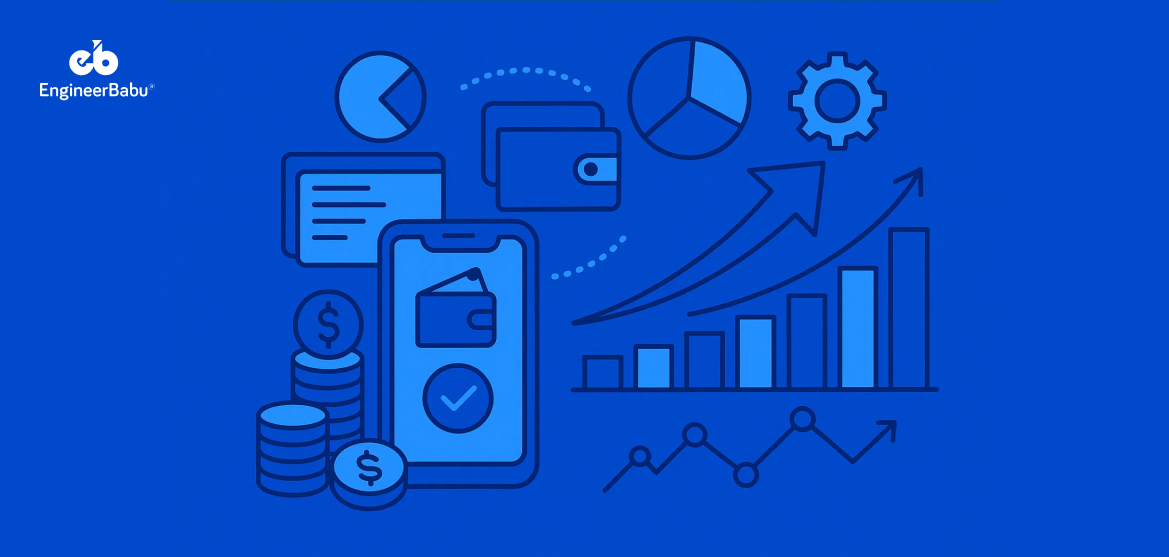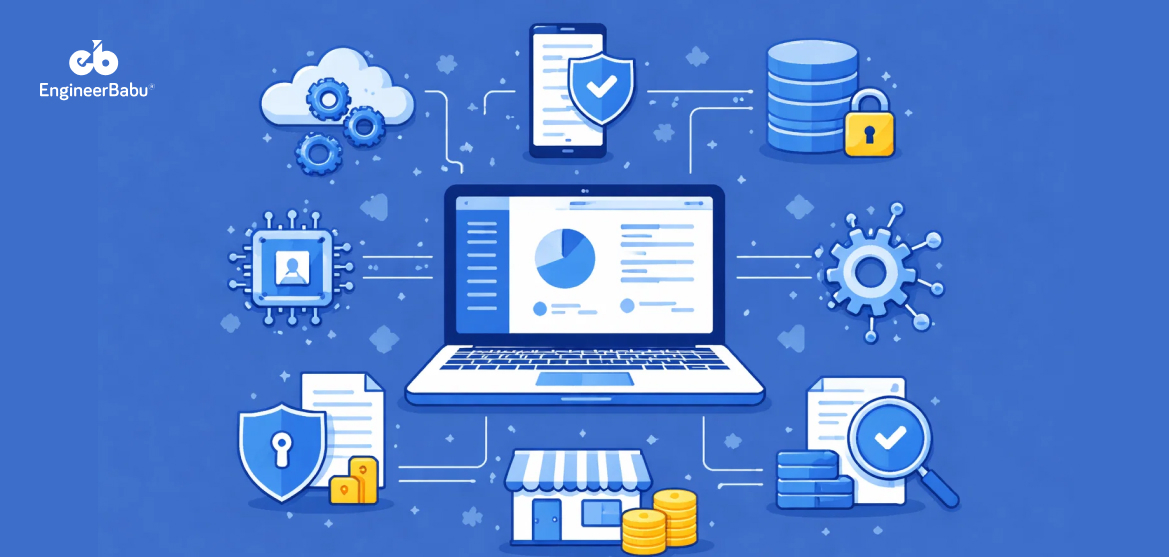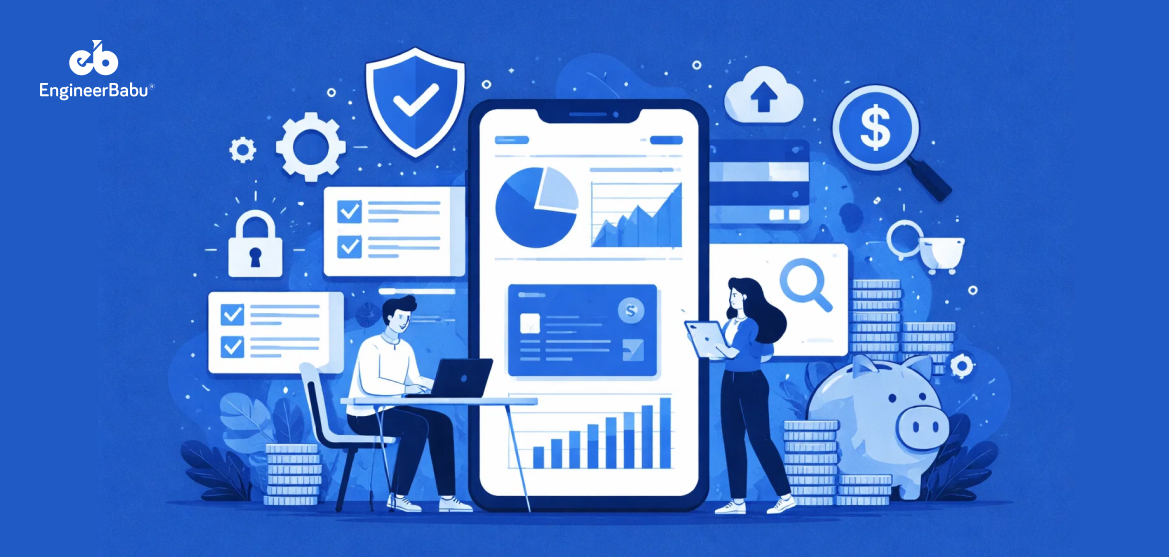More than 70% of digital-first consumers expect seamless financial services, yet nearly half abandon apps after just three months if they don’t see value. In fintech, that margin between loyalty and churn is razor-thin. This is why tracking the right performance indicators is the foundation of growth.
KPIs help you see beyond downloads and vanity metrics. They reveal whether your app is attracting the right users, retaining them long enough to create value, and generating sustainable revenue. They also uncover hidden risks, from fraud exposure to operational inefficiencies, that can quickly erode trust.
In this article, we’ll break down the key KPIs every fintech leader should monitor, spanning engagement, retention, monetization, and operations. These metrics can help you guide smarter decisions that shape both customer experience and profitability.
Must-Know Fintech KPIs to Measure App Success
Active Users (DAU/MAU)
Daily Active Users (DAU) and Monthly Active Users (MAU) show how consistently people engage with your app. A healthy ratio, often called stickiness, signals that users rely on your product regularly, not just occasionally.
For fintech apps, this is critical. If customers are not logging in to check balances, make payments, or invest, your solution is not becoming part of their financial routine. Tracking DAU/MAU trends helps you assess product-market fit and spot early warning signs of disengagement before churn escalates.
Session Length & Depth
Beyond logins, understanding how long and how deeply users interact with your app paints a clearer picture of engagement. A short session might mean users complete tasks quickly, but it could also signal limited value. Depth, or how many screens or features a user touches, shows whether customers explore beyond the basics.
In fintech, longer and richer sessions often correlate with trust and increased product adoption. For example, a user who checks balances, applies for credit, and makes a payment in one visit is far more valuable than one who only logs in briefly.
User Engagement (Broad Measure)
User engagement combines frequency, duration, and activity variety to show whether customers view your app as essential. Unlike vanity metrics, it reflects real value delivered to users. For fintech, high engagement may translate to recurring transactions, increased deposits, or consistent portfolio management.
Monitoring engagement patterns helps identify which features resonate most and where friction exists. If engagement is dropping, it is a sign that your user experience or value proposition is not strong enough. This is vital insight in a market where switching costs for customers are virtually nonexistent.
Customer Acquisition Cost (CAC)
Customer Acquisition Cost measures how much you spend to bring in a new user, factoring in marketing, sales, and onboarding expenses. In fintech, where competition is intense, a high CAC can quickly erode profitability if not balanced with long-term value. Tracking CAC helps you evaluate the efficiency of your channels and campaigns.
For example, if referral programs lower acquisition costs compared to paid ads, reallocating spend can improve ROI. The goal is to reduce CAC over time without sacrificing the quality of users you acquire.
Customer Lifetime Value (LTV)
Customer Lifetime Value estimates the total revenue a user generates throughout their relationship with your app. For fintech, this could mean transaction fees, subscription revenue, or interest spreads. A strong LTV highlights not just retention but also the depth of user engagement and monetization.
Comparing LTV with CAC is especially powerful, as it shows whether you are spending wisely to grow profitably. If your LTV is significantly higher than your CAC, your app is positioned for sustainable growth. If not, it signals the need to refine acquisition or retention strategies.
Churn Rate
Churn rate is the percentage of users who stop using your app within a given period. High churn often signals dissatisfaction, poor onboarding, or better alternatives in the market. For fintech apps, churn is particularly costly since customer trust is hard-won and expensive to replace. Monitoring churn not only reveals retention challenges but also uncovers weaknesses in your customer experience.
Reducing churn often requires analyzing user behavior before drop-off, addressing friction points, and improving support. Even small improvements can significantly impact profitability since retaining customers is far cheaper than acquiring new ones.
Net Promoter Score (NPS)
Net Promoter Score measures how likely customers are to recommend your app to others. In fintech, where trust is central, NPS is more than a loyalty metric. It provides insight into whether users view your product as reliable, valuable, and worth sharing. A high NPS can lower acquisition costs since word-of-mouth is often the strongest growth driver in financial services.
Conversely, a low NPS warns that dissatisfaction could spread quickly. Regularly surveying users and acting on their feedback ensures that NPS becomes a tool for continuous improvement rather than just a vanity score.
Retention Rate
Retention rate measures how many users continue to use your app after a specific time frame, such as 30, 60, or 90 days. In fintech, strong retention indicates that customers find consistent value, whether through daily payments, investments, or loan management. Weak retention often reveals gaps in onboarding, product design, or long-term engagement.
Improving retention requires analyzing user cohorts, identifying what keeps long-term users engaged, and replicating those experiences for new customers. Since higher retention drives up LTV, it is often the most impactful KPI for achieving sustainable profitability.
Monthly Recurring Revenue (MRR)
Monthly Recurring Revenue captures the predictable income generated from subscriptions or recurring payments. For fintech apps offering premium features, lending services, or investment management, MRR is a reliable indicator of financial stability. Tracking MRR growth highlights whether your monetization model is scaling and if new customer acquisitions are translating into steady revenue.
A sudden dip may signal churn or pricing challenges. Consistent MRR growth allows fintech companies to forecast more accurately, secure funding, and invest in product innovation with greater confidence.
Average Revenue Per User (ARPU)
ARPU calculates the average revenue generated from each active user over a given period. It is a valuable measure of how effectively you monetize your user base. In fintech, ARPU can include transaction fees, subscription revenue, or lending spreads. A rising ARPU suggests that users are engaging with higher-value services, while stagnation might indicate reliance on low-margin features.
Segmenting ARPU by user type, such as free vs. premium customers, helps refine pricing strategies and prioritize features that drive revenue growth without alienating budget-sensitive users.
Profit Margin
Profit margin reflects the percentage of revenue that remains after accounting for operating costs, customer acquisition, and transaction expenses. For fintech, where margins can be thin due to high compliance and technology costs, this KPI is a crucial measure of long-term sustainability. Monitoring profit margins helps identify inefficiencies and opportunities to streamline operations.
For example, automating KYC or fraud checks can reduce costs while improving accuracy. A growing profit margin signals that your business model is not only scaling but also becoming more efficient over time.
LTV:CAC Ratio
The LTV:CAC ratio compares the revenue generated by a customer over their lifetime to the cost of acquiring them. A ratio above 3:1 is often considered healthy in fintech, indicating that customers generate three times more value than what it cost to bring them in. Anything lower suggests that acquisition spending is not justified by long-term returns.
This KPI bridges acquisition and profitability, showing whether your growth strategy is sustainable. Tracking it over time helps adjust marketing budgets, optimize user journeys, and refine pricing to balance costs with value.
Feature Adoption Rate
Feature adoption rate shows how many users actively use specific features within your app. In fintech, this could include bill payments, investment tools, or loan applications. A high adoption rate means users see clear value, while low adoption highlights wasted development effort or poor onboarding.
Tracking adoption helps you understand which features drive retention and which need redesign. For example, if only 10% of users use a savings feature, it may need clearer placement or stronger incentives. Prioritizing high-impact features ensures resources are aligned with what customers truly want.
Transaction Volume
Transaction volume tracks the total value or number of transactions processed through your app. It is a core indicator of trust and utility in fintech. A growing volume suggests users are confident enough to rely on your platform for meaningful financial activity. Declining volumes, on the other hand, may indicate user churn, increased competition, or operational issues.
Segmenting by type of transaction, such as payments, transfers, or investments, offers deeper insights into user behavior. Sustained growth in transaction volume often correlates with stronger engagement and higher revenue potential.
Fraud Rate
Fraud rate measures the percentage of fraudulent transactions compared to total transactions. For fintech, where trust is paramount, even a small increase in fraud can damage reputation and customer loyalty. Monitoring this KPI allows you to evaluate the effectiveness of fraud prevention systems and compliance measures.
A low fraud rate signals strong security and reliability, which are essential to attract and retain users. Conversely, a rising fraud rate demands immediate attention to tighten controls, invest in fraud detection tools, and strengthen customer education on safe practices.
Conversion Rate
Conversion rate measures the percentage of users who complete a desired action, such as upgrading from a free plan to a paid one or applying for a loan. In fintech, it reflects how well your app moves users through the funnel from interest to transaction.
A high conversion rate often means that the onboarding, pricing, and feature presentation are well aligned with user needs. Tracking conversion by funnel stage helps identify where potential customers drop off. Optimizing those touchpoints can significantly boost both revenue and retention.
Operational Efficiency Ratio
Operational efficiency ratio assesses how effectively your fintech manages expenses relative to revenue. It is especially relevant for lending or transaction-heavy models, where costs can rise quickly. A lower ratio indicates that the business is generating higher revenue with proportionally lower expenses, signaling strong scalability.
Monitoring this KPI helps identify areas where automation, better vendor contracts, or streamlined workflows can cut costs. It also reassures investors and regulators that your company can handle growth without sacrificing stability.
Turnaround Time (TAT)
Turnaround time measures the duration required to complete a process, such as loan approvals, transaction settlements, or account verifications. In fintech, speed directly impacts user satisfaction and trust. A shorter TAT can be a major competitive advantage, especially when users compare apps. For example, approving a loan in minutes instead of days can drastically improve adoption.
Tracking TAT also highlights bottlenecks in operations, whether they are manual reviews, compliance checks, or system inefficiencies. Reducing turnaround time not only improves customer experience but also drives higher transaction volumes.
Conclusion
The strength of a fintech app is not in how many people download it but in how well it performs against the numbers that matter. Engagement metrics show whether customers find it useful, retention data reveals if they trust it enough to stay, financial KPIs measure sustainability, and operational indicators uncover how smoothly the engine runs.
Taken together, these insights guide decisions that shape both customer experience and long-term profitability. The apps that succeed are the ones that pay attention to these signals and act on them with discipline.
FAQs
1. Why are KPIs important for fintech apps?
KPIs provide measurable insights into user behavior, revenue generation, and operational efficiency. Without them, it is nearly impossible to identify what works, where customers drop off, or how to scale profitably.
2. What is a good DAU/MAU ratio for a fintech app?
A DAU/MAU ratio of 20% or higher is often considered healthy, showing that users engage regularly and view the app as part of their routine.
3. How do CAC and LTV work together?
CAC measures the cost of acquiring a customer, while LTV estimates the revenue that customer generates over time. Together, they show if acquisition efforts are profitable and sustainable.
4. How can fintech apps reduce churn rate?
Improving onboarding, simplifying user journeys, offering personalized features, and providing proactive customer support are proven strategies to lower churn and boost retention.
5. Which KPI is most critical for early-stage fintech apps?
While all KPIs matter, retention rate is often the most telling. If users do not stay engaged, even strong acquisition or revenue growth will eventually collapse.
6. How does EngineerBabu support fintech companies in achieving these KPIs?
Tracking KPIs is only meaningful if your app is built to deliver real value. EngineerBabu helps you hire fintech developers who understand both technology and the metrics that matter. Their team designs secure, scalable fintech solutions with features that drive engagement, retention, and revenue growth.




